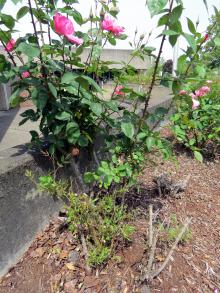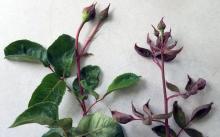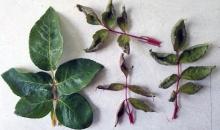Cause There are a number of herbicides available for use around roses plantings. The herbicide class and the dosage to the plant determine which symptoms appear and their severity. Injury from glyphosate (such as Roundup and related materials) is relatively common. Damage symptoms caused by this herbicide may not appear during the season of application, especially if application is made in autumn, but symptoms may appear the following spring. The plant will outgrow the injury if the dosage was not too high. Glyphosate can be absorbed through green wood of canes, so care must be taken to avoid accidental application or drift.
Some chemicals used to manage common disease, such as black spot, powdery mildew, or rust, may cause various leaf or petal spots or discoloration. Abiotic leaf spots due to many different situations, including chemicals, are a common problem sent into the OSU Plant Clinic. Always watch for warnings on labels of various products.
Symptoms Herbicide damage may appear as a variety of symptoms, including cupped, curled, or chlorotic leaves, small leaves, or necrosis of the entire plant. Injury from glyphosate in the current season may appear as bright yellow leaves on the newest growth. Symptoms may not appear until the next growing season and may appear as a proliferation of small shoots and leaves from buds. New leaves in these nodes may look needle-like and blossoms may be underdeveloped.
Cultural Control Avoid applications of herbicides in close proximity to rose plants. Never spray herbicides directly onto rose plants or let spray drift on to plants.
Reference Karlik, J.F. and Flint, M.L. 2009. Healthy Roses: Environmentally Friendly Ways to Manage Pests and Disorders in Your Garden and Landscape. UC ANR Publication 21589.





